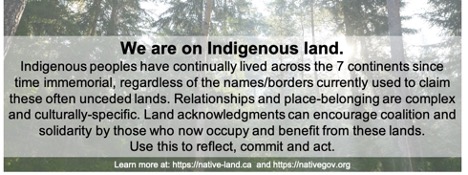Hello! We’re Michael Petillo (he/they) with CES Partnership, LLC, and Rory Neuner (she/her) with the Barr Foundation. In today’s Pride Week post, we’re excited to explore what an anti-oppression evaluation practice means, and how it can empower LGBTQ2S people (among others, too!).

Anti-Oppression & LGBTQ2S
Oppression is understood as the disempowerment, marginalization, and/or silencing of certain people/communities by systems or people in positions of power. Those with privilege and power ultimately benefit from oppression. Conversely, anti-oppression is an ongoing practice of challenging/disrupting social, economic, and political inequalities. Note the emphasis on ongoing – it’s a journey, not a destination!
Oppression can be subtle/seem invisible – rooted in Western European, colonial, patriarchal, capitalist structures. It happens at multiple, interconnected levels: ideological, institutional, interpersonal, and internalized. Need examples? Federal and state laws around marriage equality or who can use what public restroom are institutional illustrations. Heteronormative cis-centric ideologies inform these oppressive tactics, which negatively affect LGBTQ2S people – at home, work, school, and in communities. One of the most heartbreaking examples is how oppression adversely impacts LGBTQ2S youth. Being a teenager is tough enough – can het/cis folks imagine adding this layer to teenage life?!
Anti-oppression evaluation is active, ongoing (that word again!), and goes beyond “do no harm.” It‘s a commitment to unsettled witnessing, systems-level institutional inequity interrogation, social justice empowerment, and decolonizing methodologies.
An Equity Framework
Want to engage an anti-oppression evaluation practice? The Equitable Evaluation Framework (EEF) offers one path. EEF challenges ideological and institutional narratives while reimagining evaluation as grounded in three principles:
- Be in service of equity (in production, consumption, and management)
- Answer critical questions about how:
- Historical and structural decisions contribute to current conditions
- Strategic choices impact underlying systemic drivers of inequity
- Cultural contexts interact with both structural conditions and change initiatives
- Align evaluation design and implementation with equity values, which are multiculturally valid and oriented toward participant ownership.
While EEF focuses racial and economic equity within a US-based nonprofit and philanthropic foundation context, it is translatable across many other sectors and institutions. It emphasizes community complexity, multicultural contexts, individual/organizational learning, community ownership, and shifting away from limiting/oppressive narratives.
Rethink LGBTQ2S Equity
Equity initiatives should embrace LGBTQ2S intersectional identities to allow for a radical reimagining/queering of institutions aligned through community building. Otherwise, we can miss critical intracommunity contexts. For example, QTPOC community needs and experiences are unique from white LGBTQ beyond pride affinity groups. The umbrella identity “Two Spirit” encompasses many Indigenous identities/cultures/expressions. One equity model won’t work for everyone, for a myriad of cultural and community-specific reasons. But we can rethink evaluation as anti-oppression practice, or “deepen our love.”
Consider where we can:
- Challenge institutional/organizational exclusion of sexual orientation and gender identity diversity, from policy through to practice
- Divest from oppressive structures/orthodoxies/methodologies as a field
- Center LGBTQ2S and QTPOC participant involvement/ownership and value community knowledge/expertise in the process
- Expand our equity work to include multilayered intersectional axes of race, ethnicity, culture, gender identity, and sexual orientation
Rad Anti-Oppression, Equity-Based Resources:
- What is Anti-Oppression- The Anti-Oppression Network
- Anti-Oppression Framework Refresher
- Shifting the Evaluation Paradigm: The Equitable Evaluation Framework (EEF)™
- Equity and Evaluation: Models of How Equity Can and Does Impact Evaluation
- Queeruptions and the Question of QTPOC Thriving in Schools – An Excavation by Kia Darling-Hammond
- A Brief Survival Guide for Black and Brown LGBTQ Folks by Deanna Richards
- More Than Just Gay Indians: Intersecting Articulations of Two-Spirit Gender, Sexuality and Indigenousness by Jenny L. Davis
The American Evaluation Association is celebrating LGBT TIG Week with our colleagues in the Lesbian, Gay, Bisexual & Transgender Issues Topical Interest Group. The contributions all this week to aea365 come from our LGBT TIG members. Do you have questions, concerns, kudos, or content to extend this aea365 contribution? Please add them in the comments section for this post on the aea365 webpage so that we may enrich our community of practice. Would you like to submit an aea365 Tip? Please send a note of interest to aea365@eval.org. aea365 is sponsored by the American Evaluation Association and provides a Tip-a-Day by and for evaluators. The views and opinions expressed on the AEA365 blog are solely those of the original authors and other contributors. These views and opinions do not necessarily represent those of the American Evaluation Association, and/or any/all contributors to this site.

Hello Michael and Rory,
I am a teacher currently taking a course on Program Evaluation and Inquiry and I want to let you both know I found your article quite helpful. I was unfamiliar with the term “anti-oppression evaluation practice,” and you have opened my eyes in terms of the way teachers can help empower marginalized communities in our school evaluations.
School washrooms are a perfect example of a heteronormative cis-centric ideology, which negatively affects my LGBTQ2S students. Unfortunately, asking parents and Administrators to look at the issue through a new lens has fallen on deaf ears.
In the future, I will bring to the table the Equitable Evaluation Framework (EFF) to challenge this narrative. I particularly believe critically thinking about the following points will be helpful:
How strategic choices impact underlying systemic drivers of inequity
How cultural contexts interact with both structural conditions and change initiatives
Your post made me consider where I can use anti-oppression evaluation practices in the context of my International School in Mainland China. It will be essential to
challenge the policy and practice of excluding sexual orientation and gender identity expression
involve and acknowledge LGBTQ2S and QTPOC students’ knowledge and expertise in the evaluation process.
Thank you for the additional resources, I appreciate, as you said, “anti-oppression is an ongoing practice,” and thank you for equipping me with the tools to take the first steps on this journey.